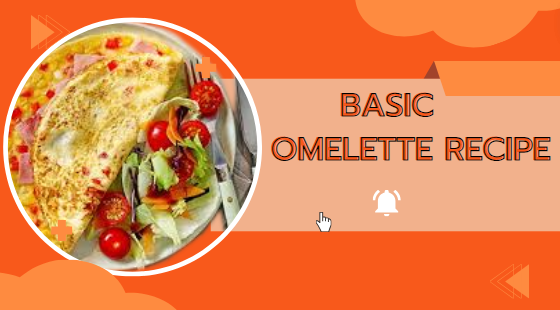Discover top omelette recipes, expert tips, and cooking techniques for a perfect breakfast. From classic to creative, learn how to make delicious omelettes
Omelette: Recipes, Tips, and Techniques for the Perfect Breakfast
An omelette is one of those magical dishes that is quick, versatile, and satisfying. Whether you want a simple breakfast or a gourmet brunch, mastering the omelette will help.
It opens up endless possibilities. In this post, I’ll share the best omelette recipes. I’ll include tips for perfect omelettes. I’ll also add advanced techniques to help you improve your omelette skills.
Why Omelettes Are the Ultimate Breakfast Staple
Omelettes are beloved worldwide for a reason: they’re quick, easy to make, and customizable. You can fill them with veggies, cheese, meats, or herbs, depending on your mood or what’s in your fridge. Plus, they’re packed with protein, making them an excellent choice to kickstart your day.
Now, let’s dive into the essential steps, recipes, and expert techniques for making an omelette you’ll love.
Basic Omelette Recipe: Simple Yet Perfect
Let’s start with the foundation – a basic omelette. You don’t need much to make one, and once you’ve nailed the basics, you can get creative with endless variations.
Ingredients:
2 3 large eggs
Salt and pepper to taste
1 tablespoon butter or cooking oil
Instructions:
- Whisk the Eggs: Crack the eggs into a bowl and whisk them with a pinch of salt and pepper until fully combined. You want the mixture to be smooth and slightly frothy – this will help make your omelette fluffier.
- Preheat the Pan: Heat a non stick skillet over medium heat and add the butter or oil. Twirl it around the dish to equitably cover the surface. 3. Cook the Omelette: Pour the whisked eggs into the hot pan. Allow them to sit for a couple of moments until the edges start to set. Use a spatula to gently push the cooked parts from the edges towards the center. Tilt the pan so the uncooked eggs can fill the gaps.
- Fold and Serve: Once the eggs are mostly set but still runny on top, fold one half over the other with your spatula. Let it cook for another 30 seconds, then slide the omelette onto a plate.
Tip: If you want a super soft and fluffy omelette, cook it on low heat and be patient!
Creative Omelette Variations
Once you’ve mastered the basic omelette, you can experiment with different fillings. Here are some crowd pleasers:
- Veggie Omelette
Packed with fresh vegetables, this omelette is both healthy and delicious.
Ingredients:
Spinach, mushrooms, bell peppers, onions (or any of your favorite veggies)
Cheese (optional)
Instructions:
Sauté your veggies in the pan before adding the eggs to soften them up. Once the veggies are tender, pour in your egg mixture, cook, and fold as described in the basic recipe.
Pro Tip: If you’re adding cheese, sprinkle it on the omelette just before folding for a gooey, melted center.
- Cheese Omelette
There’s something special about a classic cheese omelette.
Cheese Options: Cheddar, mozzarella, feta, or even goat cheese work well here. Add your favorite cheese midway through cooking so it melts perfectly.
Top Tips for the Perfect Omelette

Making a great omelette is all about technique. Here are some tried and true tips that will help you make perfect omelettes every time:
1. Use the Right Pan
A non stick skillet is your best friend when it comes to making omelettes. A well seasoned cast iron pan can also work wonders if you prefer something sturdier. Make sure the size of the pan matches the number of eggs you’re using. A small 8 or 10 inch skillet is ideal for a 2 egg omelette.
2. Don’t Overbeat the Eggs
When whisking your eggs, just mix them enough to combine the whites and yolks. Overbeating can result in a tough omelette.
3. Master the Heat
Medium to low heat is ideal for cooking omelettes. Too high, and you’ll end up with browned or overcooked eggs. If you’re aiming for soft and creamy eggs, take your time and use a gentler heat.
4. Know When to Fold
If you like a soft and runny center, fold the omelette when the top is still slightly glossy. For a fully cooked omelette, wait until the top is completely set.
Advanced Omelette Techniques
For those looking to step up their omelette game, here are a few techniques used by pros:
1. French Omelette
A French omelette is smooth and delicate. It lacks the browning of other omelettes.
Instructions:
Use low heat and continuously stir the eggs with a spatula while they cook, preventing any browning. When they’re still soft and creamy, fold the omelette into thirds and serve.
2. Spanish Omelette (Tortilla Española)
This hearty omelette has potatoes and onions. It’s often thicker than regular ones.
Instructions:
Sauté thinly sliced potatoes and onions in oil until soft, then add the eggs and cook slowly. Flip the omelette to cook both sides evenly.
3. Soufflé Omelette
For a fluffy, cloud like omelette, try the soufflé method. Separate the egg whites and yolks. Whip the whites to stiff peaks. Then, delicately overlay them into the yolks prior to cooking.
Common Omelette Mistakes to Avoid
Even experienced cooks can slip up. Here are some common mistakes to avoid when making omelettes:
Overcooking the eggs: This can lead to a rubbery texture.
Adding too many fillings: An overstuffed omelette can break apart or cook unevenly.
Using high heat: This can cause the eggs to brown too quickly and become tough.
Serving Suggestions
Omelettes pair well with a variety of sides. Here are a few ideas:
Classic Sides: Toast, hash browns, or a fresh salad.
Sauces and Condiments: A dash of hot sauce, a dollop of sour cream, or a side of salsa can add flavor.
Omelette FAQs
To wrap things up, here are some frequently asked questions about omelettes:
- Can I make an omelette without butter or oil?
Yes! You can use non stick cooking spray or a good non stick pan if you’re avoiding fats.
- How do I store leftover omelette?
While fresh is best, you can refrigerate a leftover omelette in an airtight container for up to 2 days. Warm tenderly in a skillet or microwave.
- How do I prevent my omelette from sticking?
Using a well greased, non stick skillet is key. If your omelette sticks, it’s often because the pan isn’t hot enough when you add the eggs.
Conclusion
Omelettes are a wonderful dish that can be as simple or sophisticated as you like. Making the perfect omelette is all about practice and preference. So, whether you use a basic recipe or experiment with new fillings and techniques, keep at it. So grab a pan, crack some eggs, and start cooking!
What’s your favorite way to make an omelette? Share your go to recipe or tips in the comments!
This post should resonate with your audience. It must mix simple steps, creativity, and expert techniques for all skill levels.

is a digital marketing consultant with a passion for advanced living, is the man behind this blog, where he shares his love for all things kitchen and culinary trends to help you elevate your cooking experience.



